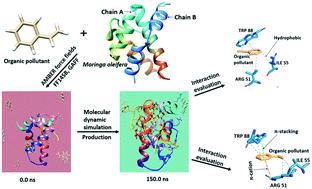当前位置:
X-MOL 学术
›
Environ. Sci.: Water Res. Technol.
›
论文详情
Our official English website, www.x-mol.net, welcomes your
feedback! (Note: you will need to create a separate account there.)
Coagulation of organic pollutants by Moringa oleifera protein molecules: in silico approach
Environmental Science: Water Research & Technology ( IF 3.5 ) Pub Date : 2021-6-4 , DOI: 10.1039/d1ew00247c Victoria T. Adeleke 1 , Adebayo A. Adeniyi 2, 3 , David Lokhat 1
Environmental Science: Water Research & Technology ( IF 3.5 ) Pub Date : 2021-6-4 , DOI: 10.1039/d1ew00247c Victoria T. Adeleke 1 , Adebayo A. Adeniyi 2, 3 , David Lokhat 1
Affiliation

|
Availability of clean water for various activities is a global challenge. Moringa oleifera (MO) seed protein extract has been identified as a natural coagulant for wastewater treatment. The mechanistic understanding of the coagulating activity of MO is poor. This study employed molecular dynamics simulation to predict and investigate the coagulation ability of known MO seed protein for the removal of four organic pollutants two of which had been previously examined experimentally. The results provide insights relating to the amino acid residues in MO and their types of interaction. An average of 80 to 90% of the pollutant ligands (average of 8 to 9 molecules out of 10 used) was found to coagulate around the MO at the end of 150 ns simulation time. The binding free energy reported was within the range of −149.88 to −51.24 kcal mol−1. Amino acid residues from both chains A and B of MO were observed to participate in the protein–ligand interactions. Many amino acid residues of MO play a significant role in the interaction of the pollutants during the simulation with their binding energies ranging from −3.925 to −1.027 kcal mol−1. Stability was reported for the MO–pollutant complexes which were observed to be strengthened majorly through hydrophobic and hydrogen bonding. The results from this investigation place more clarity on the coagulation ability of MO and give insight into the molecular activity of MO for wastewater treatment.
中文翻译:

辣木蛋白分子对有机污染物的凝结:计算机方法
为各种活动提供清洁水是一项全球性挑战。辣木(MO) 种子蛋白提取物已被确定为废水处理的天然混凝剂。对 MO 凝血活性的机制理解很差。本研究采用分子动力学模拟来预测和研究已知 MO 种子蛋白去除四种有机污染物的凝结能力,其中两种以前已通过实验进行过检验。结果提供了有关 MO 中氨基酸残基及其相互作用类型的见解。在 150 ns 模拟时间结束时,发现平均 80% 到 90% 的污染物配体(使用的 10 个分子中平均有 8 到 9 个分子)在 MO 周围凝结。报告的结合自由能在 -149.88 至 -51.24 kcal mol -1的范围内. 观察到来自 MO 链 A 和 B 的氨基酸残基参与蛋白质-配体相互作用。在模拟过程中,MO 的许多氨基酸残基在污染物的相互作用中起重要作用,其结合能范围为 -3.925 至 -1.027 kcal mol -1。据报道,MO-污染物复合物的稳定性主要通过疏水和氢键增强。这项调查的结果更清楚地说明了 MO 的混凝能力,并深入了解了 MO 在废水处理中的分子活性。
更新日期:2021-06-09
中文翻译:

辣木蛋白分子对有机污染物的凝结:计算机方法
为各种活动提供清洁水是一项全球性挑战。辣木(MO) 种子蛋白提取物已被确定为废水处理的天然混凝剂。对 MO 凝血活性的机制理解很差。本研究采用分子动力学模拟来预测和研究已知 MO 种子蛋白去除四种有机污染物的凝结能力,其中两种以前已通过实验进行过检验。结果提供了有关 MO 中氨基酸残基及其相互作用类型的见解。在 150 ns 模拟时间结束时,发现平均 80% 到 90% 的污染物配体(使用的 10 个分子中平均有 8 到 9 个分子)在 MO 周围凝结。报告的结合自由能在 -149.88 至 -51.24 kcal mol -1的范围内. 观察到来自 MO 链 A 和 B 的氨基酸残基参与蛋白质-配体相互作用。在模拟过程中,MO 的许多氨基酸残基在污染物的相互作用中起重要作用,其结合能范围为 -3.925 至 -1.027 kcal mol -1。据报道,MO-污染物复合物的稳定性主要通过疏水和氢键增强。这项调查的结果更清楚地说明了 MO 的混凝能力,并深入了解了 MO 在废水处理中的分子活性。









































 京公网安备 11010802027423号
京公网安备 11010802027423号